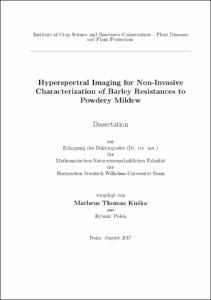Hyperspectral Imaging for Non-Invasive Characterization of Barley Resistances to Powdery Mildew

Hyperspectral Imaging for Non-Invasive Characterization of Barley Resistances to Powdery Mildew

| dc.contributor.advisor | Mahlein, Anne-Katrin | |
| dc.contributor.author | Kuśka, Matheus Thomas | |
| dc.date.accessioned | 2020-04-24T10:58:37Z | |
| dc.date.available | 2020-04-24T10:58:37Z | |
| dc.date.issued | 10.11.2017 | |
| dc.identifier.uri | https://hdl.handle.net/20.500.11811/7297 | |
| dc.description.abstract | Determination and characterization of resistance reactions of crop plants against fungal pathogens are essential to select resistant genotypes. In breeding practice phenotyping of genotypes is realized by time consuming and expensive visual plant ratings. During resistance reactions of plants and disease pathogenesis, structural and biochemical changes occur which are assumed to affect the reflectance spectra of plants specifically The aim of this study was to establish a non-invasive resistance detection and characterization using hyperspectral imaging. Therefore, a novel hyperspectral imaging microscope was developed to determine subtle changes during plant-pathogen interactions. Reflectance spectra of barley leaves with different susceptibility and resistance against Blumeria graminis f.sp. hordei (Bgh) were recorded at different timepoints after inoculation. Hyperspectral data were manually analyzed and by data driven approaches. Characteristic spectral signatures were described and biologically interpreted using histological and molecular analysis during the compatible and incompatible barley-Bgh interactions. The powdery mildew pathogenesis and mildew locus o (mlo) as well as Mildew locus a (Mla) based resistance reactions of barley were identified using hyperspectral imaging. Spectral reflectance of barley was affected by each interaction type in a characteristic way. Changes in the spectral pattern and differences in the reflectance intensities differed depending on the development stage of pathogenesis and resistance. Parallel histological and gene expression analysis provided an in-depth attribution of spectral information and temporal interaction processes on a small scale. Beside detection and characterization, Bgh pathogenesis and Mla based hypersensitive responses have been visualized by binary maps based on hyperspectral imaging data before symptoms become visible for the human eye. Spectral traces were computed by a machine learning process over an experimental period of 14 days after inoculation to uncover hyperspectral dynamics during barley-Bgh interactions. These spectral traces showed changes in hyperspectral reflectance and revealed an individual biological development. Relevant wavelengths for pathogenesis, mlo and Mla responses against Bgh were assessed using the Relief algorithm on hyperspectral images which were recorded all 3 hours after inoculation. By this relevant time points and wavelengths to distinguish between the interaction types were revealed. In addition, the Relief algorithm was applied to analyse a functional link between hyperspectral reflectance and observed gene expressions during these early barley-Bgh interactions. An interpretation of the relevant wavelengths to the biologic function of the gene transcripts was facilitated. The results of this study provide a deeper understanding of optical properties of disease plants and will promote phenotyping in resistance breeding. This information can be integrated in high-throughput phenotyping pipelines in order to evaluate the performance of multiple genotypes. Further analysis of the coherency between hyperspectral reflectance and enzyme activities, changes in secondary metabolites and hormones during barley-Bgh interactions will realize a straight forward phenotyping of genotype-pathogen interactions by hyperspectral imaging. | |
| dc.language.iso | eng | |
| dc.rights | In Copyright | |
| dc.rights.uri | http://rightsstatements.org/vocab/InC/1.0/ | |
| dc.subject | Hyperspektrales Mikroskop | |
| dc.subject | Echter Mehltau | |
| dc.subject | Wirt-Pathogen-Interaktionen | |
| dc.subject | Blumeria graminis f.sp. hordei | |
| dc.subject | Hordeum vulgare | |
| dc.subject | Phänotypisierung | |
| dc.subject | Pflanzen-Resistenzzüchtung | |
| dc.subject | optische Sensoren | |
| dc.subject | Maschinelles Lernen | |
| dc.subject | Hyperspectral microscope | |
| dc.subject | mildew locus | |
| dc.subject | host-pathogen interactions | |
| dc.subject | phenotyping | |
| dc.subject | plant resistance breeding | |
| dc.subject | optical sensors | |
| dc.subject | machine learning | |
| dc.subject.ddc | 570 Biowissenschaften, Biologie | |
| dc.title | Hyperspectral Imaging for Non-Invasive Characterization of Barley Resistances to Powdery Mildew | |
| dc.type | Dissertation oder Habilitation | |
| dc.publisher.name | Universitäts- und Landesbibliothek Bonn | |
| dc.publisher.location | Bonn | |
| dc.rights.accessRights | openAccess | |
| dc.identifier.urn | https://nbn-resolving.org/urn:nbn:de:hbz:5n-49015 | |
| ulbbn.pubtype | Erstveröffentlichung | |
| ulbbnediss.affiliation.name | Rheinische Friedrich-Wilhelms-Universität Bonn | |
| ulbbnediss.affiliation.location | Bonn | |
| ulbbnediss.thesis.level | Dissertation | |
| ulbbnediss.dissID | 4901 | |
| ulbbnediss.date.accepted | 03.11.2017 | |
| ulbbnediss.institute | Landwirtschaftliche Fakultät : Institut für Nutzpflanzenwissenschaften und Ressourcenschutz (INRES) | |
| ulbbnediss.fakultaet | Mathematisch-Naturwissenschaftliche Fakultät | |
| dc.contributor.coReferee | Bartels, Dorothea |
Files in this item
This item appears in the following Collection(s)
-
E-Dissertationen (4115)




